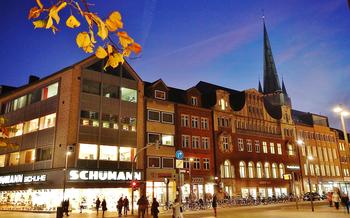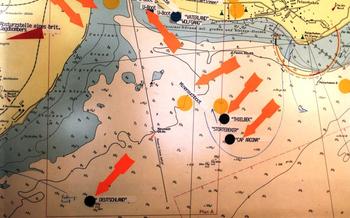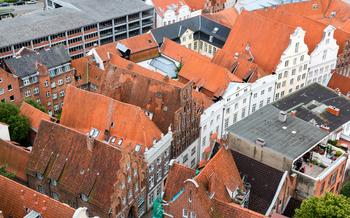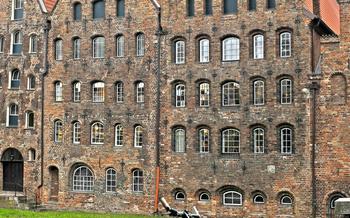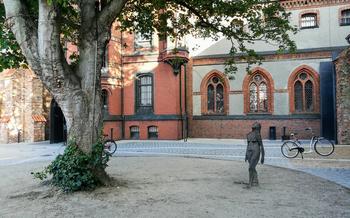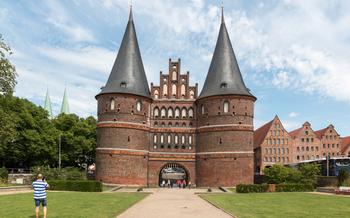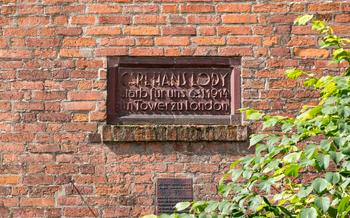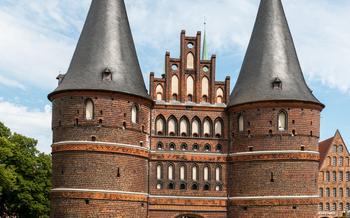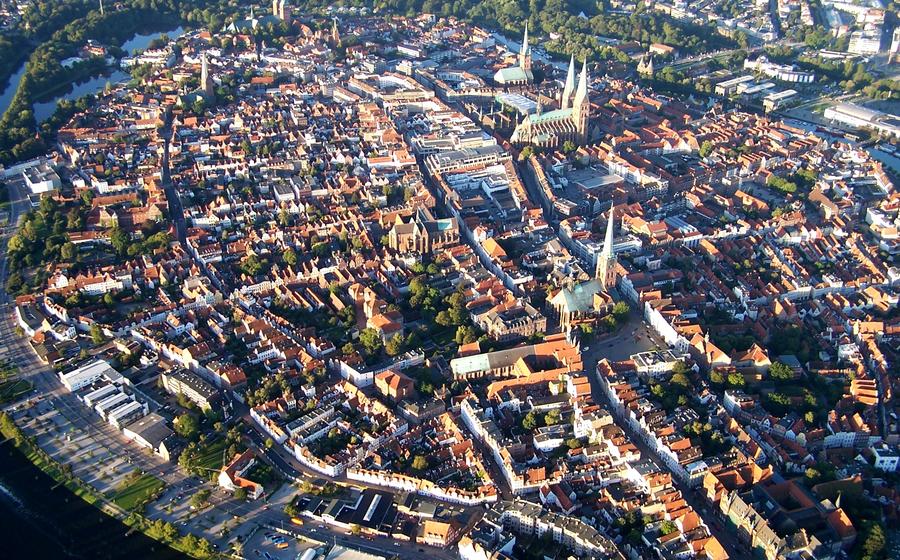
Trave River Cruises
- Lübeck's Trave River Cruises: A Panoramic Journey through History and Nature
- Historical Significance of the Trave River
- Types of Cruises Available
- Duration and Prices of the Cruises
- Unique Perspectives Offered by the Cruises
- Maritime Charm: Embracing Lübeck's Seafaring Legacy
- Holstentor: A Majestic Gateway to Lübeck's Past
- Salzspeicher: A Culinary and Cultural Haven
- Buddenbrookhaus: A Journey into Literary History
- St. Mary's Church: A Gothic Masterpiece on the Trave
- European Hansemuseum: Unraveling the Hanseatic League's Legacy
- Willy-Brandt-Haus: Honoring a Lübeck Native and Statesman
- Riverbank Promenades: Strolling along the Trave's Edge
- Boat Tours: Exploring the Trave from a Unique Vantage Point
- Biking Trails: Cycling Alongside the Trave
- Travemünde: A Seaside Escape at the Mouth of the Trave
- Insider Tip: Capturing the Magic of Lübeck's Waterways at Night
Lübeck's Trave River Cruises: A Panoramic Journey through History and Nature
Lübeck's Trave River Cruises: Embark on a captivating journey through the heart of Lübeck, Germany, aboard one of the scenic Trave River cruises. These cruises offer a unique perspective on the city's rich history, captivating natural beauty, and iconic landmarks.
Historical Significance of the Trave River
The Trave River holds immense historical significance, having served as a vital waterway for trade and transportation since the Middle Ages. The river played a crucial role in the development of Lübeck as a major trading center and member of the powerful Hanseatic League.
Types of Cruises Available
A variety of cruises are available, catering to diverse interests and preferences. From leisurely sightseeing tours that provide a comprehensive overview of Lübeck's landmarks to themed cruises that focus on specific aspects of the city's history and culture, there is a cruise to suit every traveler.
Duration and Prices of the Cruises
The duration of the cruises varies depending on the chosen itinerary, ranging from short sightseeing tours lasting around an hour to longer excursions that delve deeper into the city's history and surroundings. Prices vary accordingly, but most cruises offer affordable options to suit different budgets.
Unique Perspectives Offered by the Cruises
Trave River cruises provide a unique and unforgettable way to experience Lübeck. From the water, visitors can admire the city's skyline, marvel at the architectural wonders that line the riverbanks, and gain a deeper appreciation for Lübeck's rich maritime heritage.
Maritime Charm: Embracing Lübeck's Seafaring Legacy
Lübeck's maritime heritage is deeply intertwined with the Trave River, which has served as a vital artery for trade and commerce for centuries. As you cruise along the river, you'll be greeted by a panorama of iconic landmarks that embody the city's rich seafaring history.
The Holstentor, a majestic gateway to Lübeck's Old Town, stands as a testament to the city's defensive prowess. Its twin towers, adorned with intricate brickwork and copper spires, have become synonymous with Lübeck's skyline. The Salzspeicher, once a vital part of the city's salt trade, has been transformed into a vibrant cultural and culinary hub, offering panoramic views of the river from its rooftop terrace.
As you cruise further along the Trave, you'll pass by the Buddenbrookhaus, a restored merchant's house that once belonged to the Buddenbrook family, immortalized in the novel "Buddenbrooks" by Nobel laureate Thomas Mann. This literary landmark provides a glimpse into the lives and times of Lübeck's prosperous bourgeoisie.
St. Mary's Church, a Gothic masterpiece that dominates the cityscape, stands as a testament to Lübeck's religious heritage. Its intricate spires and flying buttresses reach towards the sky, creating a breathtaking spectacle. Climb to the top of the church tower for panoramic views of the city and the surrounding countryside.
The European Hansemuseum, located on the banks of the Trave, delves into the history of the Hanseatic League, a powerful alliance of trading cities that dominated Northern Europe during the Middle Ages. Interactive exhibits and historical artifacts bring to life the league's impact on trade, culture, and politics.
Holstentor: A Majestic Gateway to Lübeck's Past
Lübeck's Holstentor, with its twin towers and imposing red-brick façade, stands as a majestic symbol of the city's rich history. Constructed in the 15th century, this fortified gate once served as a vital defensive structure, guarding the entrance to the city from land-based attacks. Its strategic location at the end of the Trave River made it a crucial point of control for trade and commerce.
The Holstentor's architectural significance lies in its unique blend of Gothic and Renaissance styles. The towers, adorned with intricate carvings and decorative gables, showcase the city's artistic prowess. The gate features a series of arches and vaulted ceilings, creating a sense of grandeur and solidity.
Exploring the interior of the Holstentor reveals a fascinating glimpse into its past. Visitors can wander through the gate's chambers, which once housed soldiers and served as storage spaces. Exhibits and displays provide insights into the Holstentor's history, its role in Lübeck's defense, and its transformation into a museum.
Climbing to the top of the Holstentor's towers offers panoramic views of Lübeck's cityscape and the surrounding countryside. The Trave River meanders through the city, reflecting the sunlight and adding to the enchanting panorama. From this vantage point, visitors can appreciate the Holstentor's strategic position and its role in shaping Lübeck's history.
Salzspeicher: A Culinary and Cultural Haven
The Salzspeicher, once a 16th-century salt storage warehouse, has been transformed into a vibrant culinary and cultural hub. Its striking architecture, with its red brick façade and gabled roof, hints at its rich history. Inside, the Salzspeicher houses a diverse array of restaurants, cafés, and bars, each offering a unique culinary experience. From traditional German cuisine to international flavors, there's something to satisfy every palate.
Beyond its culinary offerings, the Salzspeicher is also a center for art exhibitions and cultural events. The Kunsthalle St. Annen, housed within the Salzspeicher, showcases contemporary art exhibitions throughout the year. The Salzspeicher also hosts concerts, readings, and workshops, providing a platform for local and international artists to showcase their talents.
One of the highlights of the Salzspeicher is its rooftop terrace, which offers panoramic views of Lübeck's cityscape and the Trave River. Visitors can enjoy a leisurely meal or a refreshing drink while taking in the stunning views. The Salzspeicher's transformation from a historical warehouse to a vibrant cultural and culinary center is a testament to Lübeck's ability to blend its rich heritage with modern-day innovation.
Buddenbrookhaus: A Journey into Literary History
In the heart of Lübeck, nestled amidst the historical buildings of the Old Town, stands the Buddenbrookhaus, a cultural landmark immortalized by the literary genius of Thomas Mann. This magnificent 18th-century merchant house served as the inspiration for Mann's renowned novel, "Buddenbrooks: The Decline of a Family," a masterpiece that chronicles the rise and fall of a prominent Lübeck family.
Step into the restored Buddenbrookhaus and embark on a journey through time, tracing the footsteps of the Buddenbrook clan. The house has been meticulously preserved and transformed into a museum, offering visitors a glimpse into the opulent lifestyle and intricate relationships of the Buddenbrook family.
Explore the various rooms of the Buddenbrookhaus, each meticulously decorated with period furniture, artwork, and personal belongings that bring the novel's characters to life. Learn about the family's patriarch, Johann Buddenbrook, a successful merchant who laid the foundation for the family's fortune, and his descendants, who struggled to maintain the family's legacy.
The Buddenbrookhaus also hosts literary events, exhibitions, and readings, allowing visitors to delve deeper into the world of Thomas Mann and his literary legacy. Immerse yourself in the poignant story of the Buddenbrooks, and gain a profound understanding of the social and cultural changes that shaped Lübeck and Germany during the 19th century.
St. Mary's Church: A Gothic Masterpiece on the Trave
Towering majestically over the Trave River, St. Mary's Church stands as a testament to Lübeck's rich architectural heritage. Constructed between the 13th and 15th centuries, this Gothic masterpiece boasts intricate details that captivate visitors from afar. Its exterior is adorned with flying buttresses, spires, and a mesmerizing array of sculptures depicting biblical scenes and figures. The interior of the church is equally awe-inspiring, featuring vaulted ceilings, stained glass windows, and an exquisitely carved altar. The church's most striking feature is its towering steeple, which offers panoramic views of the city and the river. Climbing the 200 steps to the top is a must for those seeking breathtaking vistas and a unique perspective of Lübeck.
European Hansemuseum: Unraveling the Hanseatic League's Legacy
Lübeck's history is inextricably linked to the Hanseatic League, a powerful alliance of trading cities that dominated Northern European commerce for centuries. The European Hansemuseum offers a fascinating journey into this rich past, showcasing the league's impact on trade, culture, and the rise of Lübeck as a leading Hanseatic city.
Through interactive exhibits and historical artifacts, the museum brings the Hanseatic era to life. Visitors can trace the league's expansion across Europe, learn about the goods that were traded, and explore the intricate network of alliances and rivalries that shaped its history. The museum also sheds light on the league's decline and the factors that led to its eventual dissolution.
A visit to the European Hansemuseum is a must for anyone interested in understanding Lübeck's role in this pivotal period of European history. The museum's engaging displays and informative exhibits provide a comprehensive overview of the Hanseatic League's legacy, offering insights into the economic, political, and cultural forces that shaped the medieval world.
Willy-Brandt-Haus: Honoring a Lübeck Native and Statesman
Willy Brandt, a Lübeck native and former West German Chancellor, was a prominent figure in German and international politics. The Willy-Brandt-Haus, located in the heart of the city, pays tribute to his life and achievements. This museum offers a comprehensive insight into Brandt's political career, showcasing exhibits that highlight his role in shaping Germany's postwar history. Visitors can explore the various stages of Brandt's political journey, from his early involvement in the resistance against Nazi Germany to his leadership as Chancellor during the era of Ostpolitik. The museum also examines Brandt's international diplomacy, particularly his efforts to promote peace and reconciliation between East and West. Through interactive displays, multimedia presentations, and personal artifacts, the Willy-Brandt-Haus offers a compelling narrative of a remarkable statesman who left an enduring legacy on German and European history.
Riverbank Promenades: Strolling along the Trave's Edge
Indulge in leisurely strolls along the picturesque riverbank promenades of Lübeck, where tranquility and scenic beauty converge. These paths, meticulously adorned with vibrant flora, offer a serene escape from the urban hustle and bustle. Embrace the tranquility as you meander alongside the Trave's edge, allowing the gentle lapping of the water to soothe your senses.
From these promenades, Lübeck's cityscape unveils itself in all its glory. Admire the architectural marvels that grace the riverbanks, each building narrating a chapter in the city's rich history. The Holstentor, with its imposing brick facade, stands as a testament to Lübeck's defensive prowess. The spires of St. Mary's Church pierce the sky, beckoning visitors to explore its Gothic grandeur.
Take a moment to pause and savor the panoramic vistas that unfold before you. The river, shimmering under the sun's golden rays, reflects the vibrant hues of the city's rooftops. Allow your gaze to wander across the expanse of the Trave, observing the graceful swans gliding effortlessly across its surface.
These riverbank promenades are not merely paths for strolling; they are havens for relaxation and contemplation. Find a secluded bench beneath the shade of a willow tree and let your thoughts drift away as you immerse yourself in the tranquility of your surroundings. Embrace the serenity of the riverbanks, allowing the gentle rhythm of the Trave to lull you into a state of tranquility.
Boat Tours: Exploring the Trave from a Unique Vantage Point
Lübeck's waterways offer a unique perspective from which to experience the city's charm and history. A variety of boat tours are available, catering to different interests and preferences. Guided tours provide informative insights into the city's landmarks and rich history, while themed tours offer unique experiences such as sunset cruises, culinary tours, and even ghost tours.
For those seeking a more intimate experience, private boat tours can be arranged, allowing visitors to customize their itinerary and explore hidden gems along the river. Whether you opt for a leisurely sightseeing cruise or an adventurous speedboat ride, exploring the Trave by boat is an unforgettable way to discover the city's beauty and charm.
Insider Tip: For a truly magical experience, consider taking a night cruise along the Trave. As darkness descends, the city's landmarks illuminate, creating a breathtaking reflection on the water's surface. Capture the beauty of Lübeck's waterways under the starry sky and create lasting memories.
Biking Trails: Cycling Alongside the Trave
Lübeck offers an extensive network of biking trails that meander alongside the Trave River, providing a scenic and eco-friendly way to explore the city and its surroundings. These well-maintained trails cater to cyclists of all levels, from leisurely riders to avid enthusiasts.
Panoramic Routes and Countryside Charms: Embark on a leisurely cycling journey along the Trave, taking in the picturesque landscapes that unfold along the way. The routes offer panoramic views of the river, the cityscape, and the lush greenery that surrounds Lübeck. Escape the urban hustle and bustle as you pedal through charming villages, tranquil meadows, and serene forests, immersing yourself in the natural beauty of the region.
Exploring the Surroundings by Bike: The biking trails extend beyond the city limits, inviting you to explore the wider region. Discover hidden gems, such as idyllic lakes, enchanting castles, and traditional German villages. Cycle through the Holsteinische Schweiz nature reserve, renowned for its rolling hills, sparkling lakes, and dense forests. Embrace the freedom of exploring at your own pace, stopping whenever you like to admire the scenery, visit local attractions, or savor a delicious meal at a traditional German restaurant.
Combining Exercise with Sightseeing: Cycling along the Trave is an excellent way to combine exercise with sightseeing. The relatively flat terrain makes it an accessible activity for riders of all fitness levels. As you pedal along the riverbanks, you'll encounter historical landmarks, architectural wonders, and cultural attractions. Stop to explore the medieval Holstentor gate, marvel at the Gothic grandeur of St. Mary's Church, or visit the European Hansemuseum to delve into the city's rich trading history.
Whether you're a seasoned cyclist seeking an exhilarating ride or a casual enthusiast looking for a leisurely exploration, Lübeck's biking trails offer a unique and rewarding experience. Embrace the freedom of two wheels and discover the captivating beauty of the Trave River and its surroundings.
Travemünde: A Seaside Escape at the Mouth of the Trave
At the point where the Trave River meets the Baltic Sea, the charming coastal town of Travemünde awaits. This picturesque destination offers a delightful escape from the urban bustle of Lübeck, inviting visitors to embrace the tranquility of the seaside. With its sandy beaches, refreshing sea breezes, and a charming promenade lined with cafes and shops, Travemünde exudes a relaxed and inviting atmosphere.
Whether you choose to embark on a day trip or extend your stay overnight, Travemünde offers a wealth of attractions to captivate your senses. Stroll along the scenic promenade, admiring the colorful beach huts and the vast expanse of the sea. Indulge in fresh seafood delicacies at one of the many restaurants, savoring the flavors of the Baltic Sea. As the sun begins to set, the sky transforms into a canvas of vibrant hues, creating a magical ambiance that will leave you spellbound.
For those seeking adventure, Travemünde offers a range of water sports activities, including sailing, windsurfing, and kitesurfing. The gentle waves and consistent winds make it an ideal spot for both beginners and experienced enthusiasts. Take advantage of the opportunity to explore the surrounding coastline by kayak or stand-up paddleboard, discovering hidden coves and secluded beaches.
Whether you seek relaxation, adventure, or a combination of both, Travemünde promises an unforgettable experience at the mouth of the Trave River. Immerse yourself in the tranquility of the seaside, embrace the vibrant atmosphere, and create lasting memories in this charming coastal town.
Insider Tip: Capturing the Magic of Lübeck's Waterways at Night
As the sun bids farewell to Lübeck, the city's waterways transform into a mesmerizing spectacle. The gentle glow of illuminations casts a warm embrace upon the Trave River and its surroundings, creating an atmosphere of enchantment. Whether you choose to embark on a tranquil night cruise or simply stroll along the riverbanks, the magic of Lübeck's waterways at night will captivate your senses.
Picture postcard views unfold as the historic buildings lining the riverbanks are adorned with soft lights, their reflections dancing upon the water's surface. The Holstentor, with its imposing silhouette, stands as a silent sentinel, its grandeur enhanced by the ethereal glow. The Salzspeicher, once a bustling center of trade, now transformed into a cultural haven, exudes an air of timeless elegance as its rooftop terrace beckons visitors to witness the city's transformation under the starry sky.
For photography enthusiasts, the night offers a unique opportunity to capture the essence of Lübeck's maritime heritage. The interplay of light and shadow creates dramatic compositions, allowing you to immortalize the city's beauty from a fresh perspective. Whether you prefer long exposure shots to capture the ethereal trails of light dancing on the water's surface or candid moments of locals and tourists enjoying the evening promenade, Lübeck's waterways at night provide endless inspiration for your lens.
As you wander along the riverbanks, the gentle lapping of the water against the shore creates a soothing symphony, inviting you to slow down and savor the tranquility of the moment. The air is filled with a sense of peace and serenity, allowing you to escape the hustle and bustle of everyday life and immerse yourself in the magic of Lübeck's waterways.
Whether you're a seasoned traveler or a first-time visitor, experiencing Lübeck's waterways at night is an unforgettable experience that will leave you with lasting memories. So, as the sun sets over this enchanting city, embrace the opportunity to witness its transformation and discover the hidden beauty that emerges under the cloak of darkness.
